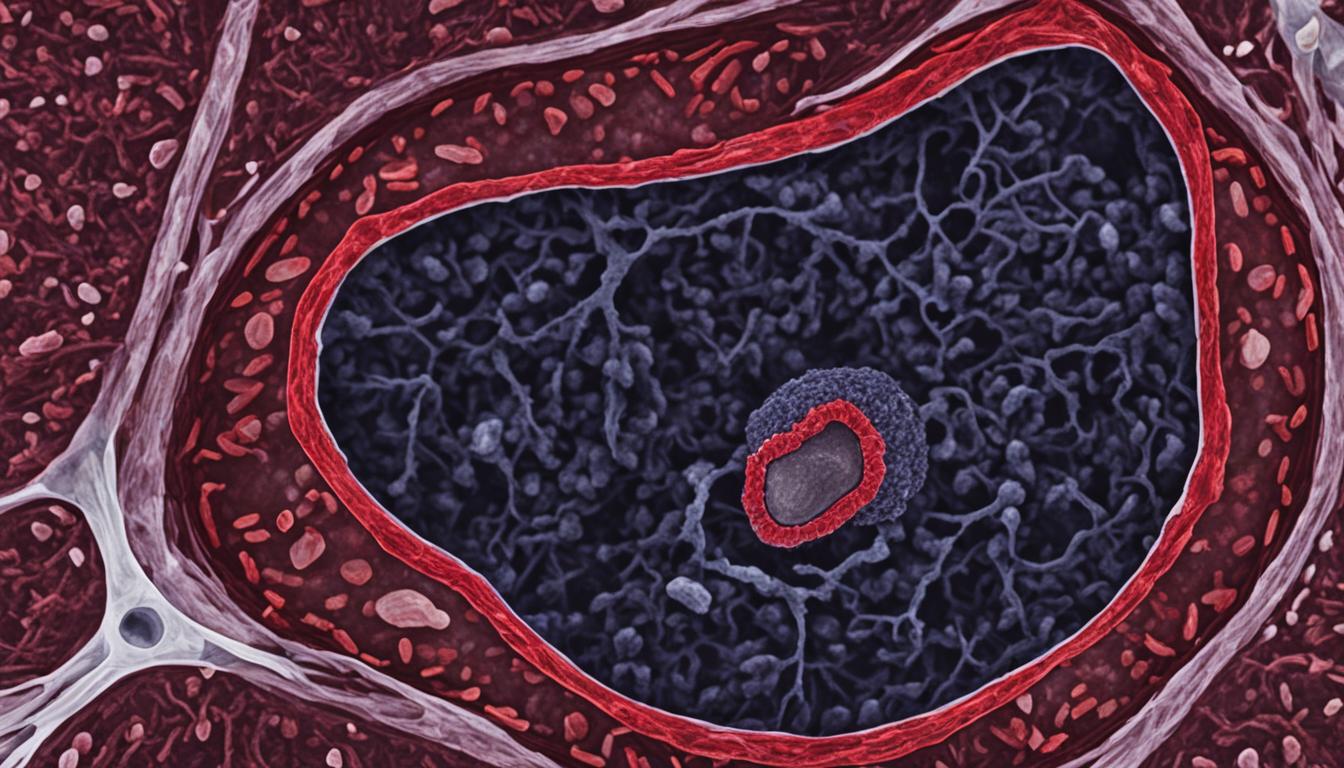Welcome to our comprehensive guide on clinically significant prostate cancer. In this section, we will delve into what clinically significant prostate cancer is and why it is important to understand this term. By the end of this article, you will have a clearer picture of how this type of prostate cancer is diagnosed, treated, and managed.
Key Takeaways:
- Clinically significant prostate cancer refers to aggressive prostate cancer that is likely to spread if left untreated.
- Screening methods such as the prostate-specific antigen (PSA) test and prostate biopsy are used to diagnose clinically significant prostate cancer.
- Low-risk prostate cancer, also known as clinically insignificant cancer, may be managed through active surveillance.
Prostate Cancer Diagnosis and Screening Guidelines
When it comes to prostate cancer, early detection is key. Regular screenings can help detect prostate cancer in its early stages, increasing the chances of successful treatment. Let’s delve into the different methods used for prostate cancer diagnosis and the screening guidelines that should be followed.
Prostate-Specific Antigen (PSA) Test
The PSA test is a common screening tool used to detect prostate cancer. It measures the levels of prostate-specific antigen in the blood. Elevated PSA levels can indicate the presence of prostate cancer, although high levels can also be caused by non-cancerous conditions such as an enlarged prostate or infection. If abnormal PSA levels are detected, further testing is usually recommended.
Digital Rectal Exam (DRE) and Biomarker Screening
Alongside the PSA test, other methods such as the Digital Rectal Exam (DRE) and biomarker screening may be utilized to provide a more comprehensive evaluation. During a DRE, a healthcare professional examines the prostate gland by inserting a gloved finger into the rectum to feel for any abnormalities. Biomarker screening involves testing for specific proteins or genetic markers associated with prostate cancer.
Prostate Biopsy
“In cases where abnormal screening results are found, a prostate biopsy is often performed to confirm the presence of cancer cells,” highlights Dr. Matthew Thompson, a renowned urologist.
A prostate biopsy involves the removal of small tissue samples from the prostate gland to be examined under a microscope for the presence of cancer cells. This procedure provides a definitive diagnosis and helps determine the stage and aggressiveness of the cancer.
Screening Guidelines
Screening guidelines for prostate cancer vary depending on age and risk factors. It is important to stay informed about these guidelines to ensure timely screenings. Common recommendations include:
- Annual screenings for men aged 50 and above, or earlier for those with higher risk factors such as African American men or men with a family history of prostate cancer.
- Discussing screening options and guidelines with a healthcare provider to create an individualized screening plan.
It’s important to note that not all experts agree on the benefits and potential harms of prostate cancer screening. Shared decision-making with a healthcare provider is crucial in determining the most appropriate approach based on individual factors and preferences.
To summarize, prostate cancer diagnosis involves the use of screening methods such as the PSA test, DRE, and biomarker screening. If abnormalities are detected, a prostate biopsy is performed to confirm the presence of cancer cells. Following screening guidelines, based on age and risk factors, is crucial in the early detection and management of prostate cancer.
Prostate Cancer Diagnosis and Screening Guidelines
| Age Group | Screening Recommendation |
|---|---|
| Above 50 | Annual screenings recommended |
| High Risk (African American men, family history) | Consider screenings at an earlier age |
Prostate Cancer Treatment Options
When it comes to prostate cancer, the choice of treatment is not one-size-fits-all. It depends on several factors, such as the stage and aggressiveness of the cancer, as well as the patient’s overall health. At our clinic, we offer a range of treatment options tailored to each individual’s specific needs.
Surgery
Surgery, or prostatectomy, is a common treatment option for localized prostate cancer. It involves the removal of the prostate gland and nearby tissues. This procedure may be recommended for patients with early-stage prostate cancer who are in good overall health. It can be performed through traditional open surgery or minimally invasive techniques such as robotic-assisted surgery.
Radiation Therapy
Radiation therapy uses high-energy rays, such as X-rays or protons, to kill cancer cells and shrink tumors. External beam radiation therapy is a non-invasive treatment that delivers radiation from outside the body directly to the tumor. Brachytherapy, on the other hand, involves the placement of radioactive seeds directly into the prostate. Radiation therapy is often used as a primary treatment for localized prostate cancer or as an adjuvant therapy after surgery.
Hormone Therapy
Hormone therapy aims to reduce the levels of testosterone in the body, as prostate cancer cells rely on this hormone to grow. This treatment can be achieved through medications that either block the production of testosterone or prevent its action. Hormone therapy is often used in combination with other treatments for advanced or recurrent prostate cancer.
Chemotherapy
Chemotherapy uses drugs to kill cancer cells or stop their growth. It may be recommended for patients with advanced prostate cancer that has spread to other parts of the body. Chemotherapy can help control symptoms and improve overall survival rates. However, it is often used after other treatments have been tried or in combination with hormone therapy.
Advanced Treatment Options
In cases of advanced prostate cancer, where the cancer has spread beyond the prostate, we offer advanced treatment options such as targeted therapies and immunotherapy. These innovative therapies specifically target cancer cells or strengthen the body’s immune response against cancer, offering hope and improved outcomes for patients.
At our clinic, our experienced healthcare team will guide you through the treatment decision-making process, taking into account the potential benefits and side effects of each option. We believe in shared decision-making, where you play an active role in choosing the treatment that best aligns with your goals and values.
Take a look at the table below for a side-by-side comparison of the different prostate cancer treatment options:
| Treatment Option | Description | Indication |
|---|---|---|
| Surgery (Prostatectomy) | Removal of the prostate gland and nearby tissues | Localized prostate cancer |
| Radiation Therapy | Use of high-energy rays to kill cancer cells | Localized prostate cancer |
| Hormone Therapy | Reduction of testosterone levels to inhibit cancer growth | Advanced or recurrent prostate cancer |
| Chemotherapy | Use of drugs to kill cancer cells or stop their growth | Advanced prostate cancer |
| Targeted Therapies | Treatments that specifically target cancer cells | Advanced prostate cancer |
| Immunotherapy | Treatments that enhance the body’s immune response against cancer | Advanced prostate cancer |

Remember, early detection and prompt treatment are crucial in improving prostate cancer outcomes. Our dedicated team is here to support you every step of the way, helping you make informed decisions about your prostate cancer journey.
Managing Prostate Cancer Side Effects
Treatment for prostate cancer can have various side effects that may impact a patient’s quality of life. It is important to effectively manage these side effects to ensure the overall well-being of the individual. By working closely with your healthcare team, you can navigate through these challenges and optimize your daily living.

- Urinary Incontinence: Difficulty controlling urine flow or leakage.
- Erectile Dysfunction: Challenges achieving or maintaining an erection.
- Fatigue: Persistent tiredness and lack of energy.
- Changes in Bowel Function: Altered bowel movements or bowel control.
Your healthcare team will provide guidance and support tailored to your specific situation. Strategies for managing these side effects may include:
- Physical Therapy: Specialized exercises and techniques to address urinary incontinence and erectile dysfunction.
- Medication: Prescription drugs that can help improve symptoms or alleviate side effects.
- Lifestyle Changes: Incorporating healthy habits such as regular exercise, a balanced diet, and stress management techniques.
- Counseling: Emotional support and guidance to navigate through the challenges associated with prostate cancer treatment.
Remember, you are not alone. Support groups and resources are available to provide additional guidance and comfort throughout your journey. Discussing your concerns and seeking the help you need will empower you to cope effectively with prostate cancer treatment side effects.
“Managing side effects is an essential component of your prostate cancer journey. By proactively addressing these challenges, we can enhance your quality of life and overall well-being.”
Risk Factors and Symptoms of Prostate Cancer
Prostate cancer is a complex disease influenced by various risk factors. It is important to be aware of these factors and discuss them with a healthcare provider to understand your individual risk. The following are some common risk factors for prostate cancer:
- Age: The risk of prostate cancer increases with age, especially after the age of 50.
- Family History: Having a family history of prostate cancer, particularly in a first-degree relative, such as a father or brother, increases the risk.
- Race: African American men have a higher risk of developing prostate cancer compared to men of other races.
- Genetic Mutations: Certain genetic mutations, such as BRCA1 and BRCA2, have been linked to an increased risk of prostate cancer.
In addition to risk factors, it is essential to recognize the symptoms of prostate cancer, as early detection can significantly impact treatment outcomes. Common symptoms of prostate cancer may include:
- Urinary changes: Frequent urination, weak urine flow, difficulty starting or stopping urination, or blood in the urine.
- Erectile dysfunction: Difficulty achieving or maintaining an erection.
- Pain or discomfort: Persistent pain or discomfort in the pelvic area, lower back, or thighs.
- Unexplained weight loss: Sudden and unexplained weight loss without changes in diet or exercise.
If you experience any of these symptoms, it is crucial to seek medical attention promptly. Early detection and timely treatment can greatly improve outcomes for individuals with prostate cancer.
“Understanding the risk factors and symptoms of prostate cancer empowers individuals to take control of their health and seek appropriate medical care when needed.”
– Prostate Cancer Awareness Foundation
Illustrative Example: Prostate Cancer Risk Factors by Age Group
| Age Group | Prostate Cancer Risk |
|---|---|
| 50-59 years | Moderate risk |
| 60-69 years | Increased risk |
| 70+ years | High risk |
This table illustrates the increasing risk of prostate cancer with age. Understanding the risk associated with different age groups can help individuals and healthcare providers make informed decisions about screening and preventive measures.
Early Detection and Prostate Cancer Survival Rates
Early detection plays a crucial role in the successful treatment of prostate cancer. By regularly screening for prostate cancer, we can identify the disease in its early stages, when it is most treatable. This proactive approach significantly improves the chances of positive outcomes and higher survival rates.
| Stage | Five-Year Survival Rate | Ten-Year Survival Rate |
|---|---|---|
| Localized Prostate Cancer | Nearly 100% | Around 98% |
| Advanced or Metastatic Prostate Cancer | Significantly decreased | Decreased |
According to the data, the five-year survival rate for localized prostate cancer is nearly 100%, offering patients great hope for a favorable prognosis. As we move to the ten-year mark, the survival rate remains high at around 98%. However, it is important to note that the survival rate decreases significantly for advanced or metastatic prostate cancer. Detecting prostate cancer early allows for a range of treatment options and improves the chances of long-term survival and recovery.
Remember, early detection is the key to successful treatment. By undergoing regular screenings for prostate cancer and working closely with our healthcare team, we can ensure that any potential signs are identified and addressed promptly. Let’s prioritize our health and take proactive steps towards early detection and improved survival rates.
Resources for Early Detection and Support
- Prostate Cancer Foundation (www.pcf.org)
- American Cancer Society (www.cancer.org)
- National Comprehensive Cancer Network (www.nccn.org)
Conclusion
When it comes to managing prostate cancer, informed healthcare decisions are crucial. By understanding the concept of clinically significant prostate cancer, individuals can take an active role in their treatment journey. From diagnosis to treatment options, staying informed is key to making the best decisions for one’s health.
Screening guidelines provide important benchmarks for early detection, ensuring that potential signs of prostate cancer are not missed. Regular screenings, including PSA tests and other screening methods, can help detect prostate cancer in its early stages, increasing the chances of successful treatment.
Prostate cancer management strategies encompass a range of options, such as surgery, radiation therapy, hormone therapy, and chemotherapy. Each treatment option has its own benefits and potential side effects. Working closely with a healthcare team is essential to tailor the treatment plan to individual needs, preferences, and overall health.
By taking an active role in their prostate cancer journey, individuals can make informed decisions, maximizing their chances of positive outcomes. This involves maintaining open communication with healthcare professionals, staying up to date on the latest research and advancements, and seeking support from resources and support groups.
FAQ
What is clinically significant prostate cancer?
Clinically significant prostate cancer refers to aggressive prostate cancer that is likely to spread if not treated and poses a risk to the patient. It is important to understand this term in the context of diagnosing and managing prostate cancer.
How is prostate cancer diagnosed?
Prostate cancer diagnosis typically involves screening with a prostate-specific antigen (PSA) test and may also include other methods such as a digital rectal exam (DRE) or biomarker screening. If abnormal results are found, a prostate biopsy is often performed to confirm the presence of cancer cells.
What are the treatment options for prostate cancer?
Prostate cancer treatment options depend on various factors such as the stage and aggressiveness of the cancer, as well as the patient’s overall health. Common treatments include surgery (prostatectomy), radiation therapy (external beam radiation or brachytherapy), hormone therapy, and chemotherapy. In advanced cases, targeted therapies and immunotherapy may be used.
How can prostate cancer side effects be managed?
Treatment for prostate cancer can cause side effects that impact a patient’s quality of life. These may include urinary incontinence, erectile dysfunction, fatigue, and changes in bowel function. It is important for patients to work closely with their healthcare team to manage these side effects through strategies such as physical therapy, medication, lifestyle changes, and counseling.
What are the risk factors and symptoms of prostate cancer?
Risk factors for prostate cancer include age, family history, race, and certain genetic mutations. Symptoms may include urinary changes, erectile dysfunction, pelvic pain or discomfort, and unexplained weight loss. It is important to be aware of these risk factors and seek medical attention if any symptoms are present.
How important is early detection in prostate cancer?
Early detection of prostate cancer through regular screenings can increase the chances of successful treatment and improved outcomes. The five-year survival rate for localized prostate cancer is nearly 100%, and the ten-year survival rate is around 98%. Catching prostate cancer in its early stages is crucial to maximize treatment options and improve survival rates.
What strategies can help manage prostate cancer?
Strategies for managing prostate cancer include regular screenings, discussing risk factors with a healthcare provider, following treatment recommendations, and staying informed about available resources and support groups. By working closely with their healthcare team and making informed healthcare decisions, patients can effectively manage prostate cancer and improve their overall outcomes.
Does Prostate Cancer Radiotherapy Help in Treating Clinically Significant Prostate Cancer?
Prostate Cancer radiotherapy sessions can be effective in treating clinically significant prostate cancer. This treatment targets the affected area directly, minimizing damage to surrounding healthy tissue. It may be used as the primary treatment or in combination with other therapies to achieve the best possible outcome for the patient.



